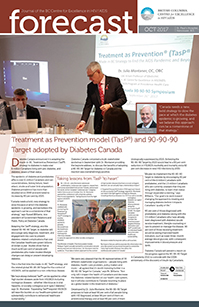
Diabetes Canada announced it is adapting the made-in-BC Treatment as Prevention (TasP) strategy to diabetes to make over 6 million Canadians living with pre-diabetes, and diabetes, aware of their status.
The epidemic of diabetes and prediabetes affects over 11 million Canadians and can cause blindness, kidney failure, heart attack, stroke and lower limb amputation. Diabetes prevalence has more than doubled since 2000 and estimated to increase by 40 per cent by 2025.
“Canada needs a bold, new strategy to slow the pace at which the diabetes epidemic is growing, and we believe this approach can be a cornerstone of that strategy,” says Russell Williams, vice president of Government Relations and Public Policy at Diabetes Canada.
Adapting the TasP strategy, and the related 90-90-90 Target, to diabetes will encourage early diagnosis, treatment, and engagement into care to prevent diabetes-related complications that cost the Canadian healthcare system billions of dollars a year. Studies show that as much as 60 per cent of people with prediabetes who make modest lifestyle changes can delay or prevent developing diabetes.
This is the first time the made-in-BC TasP strategy, and the related global 90-90-90 Target for the control of HIV/AIDS, will be applied to a non-infectious disease.
“We have always believed TasP can be applied to other high burden diseases aside from HIV/AIDS including contagious diseases – whether infectious as in viral hepatitis, or socially contagious as in type 2 diabetes,” says Dr. Montaner. “Expanding TasP® beyond HIV/AIDS will ease the burden on our healthcare system and substantially contribute to enhanced healthcare sustainability.”
Diabetes Canada convened a multi-stakeholder workshop in September with Dr. Montaner providing the keynote address, to discuss the benefits of adopting a 90-90-90 Target for diabetes in Canada and the reaction was overwhelmingly positive.
“We were very pleased that the 48 representatives of 30 different stakeholder organizations – people living with diabetes, health-care providers, policy makers and more – all agreed that it’s worth investing further in a 90-90-90 Target for Canada,” says Mr. Williams. “Not only will it impact the health of Canadians and decrease the diabetes-related burden on our health-care system, but it will also contribute to Canada resuming its place as a global leader in the treatment of diabetes.”
Developed by Dr. Julio Montaner, the 90-90-90 Target proposes to have at least 90 per cent of all people living with HIV diagnosed, at least 90 per cent of them on antiretroviral therapy and at least 90 per cent of them virologically suppressed by 2020. Achieving the 90-90-90 Target by 2020 would lead to a 90 per cent reduction in HIV/AIDS morbidity and mortality and a 90 per cent decrease in new HIV infections by 2030.
“We plan to implement the 90-90-90 Target to diabetes by encouraging 90 per cent of the 6 million Canadians with prediabetes, and the 1.5 million Canadians who are currently unaware that they are living with diabetes, to learn their status through expanded screening,” says Williams. “Our goal is to work toward changing the approach to treating and managing diabetes before it impacts Canadians’ quality of life.”
90 per cent of those diagnosed with prediabetes and diabetes (along with the 3.5 million Canadians who have already been diagnosed with diabetes) would receive treatment, lifestyle counseling or care to prevent or manage the disease. 90 per cent of those receiving treatment would be seeing improved health indicators, such as lower three-month average blood glucose, with consequent improvements in blood pressure and lipids.
Diabetes Canada will present a report on the progress against the 90-90-90 Target in Canada by 2021 to coincide with the 100th anniversary of the discovery of insulin by Canadians.

